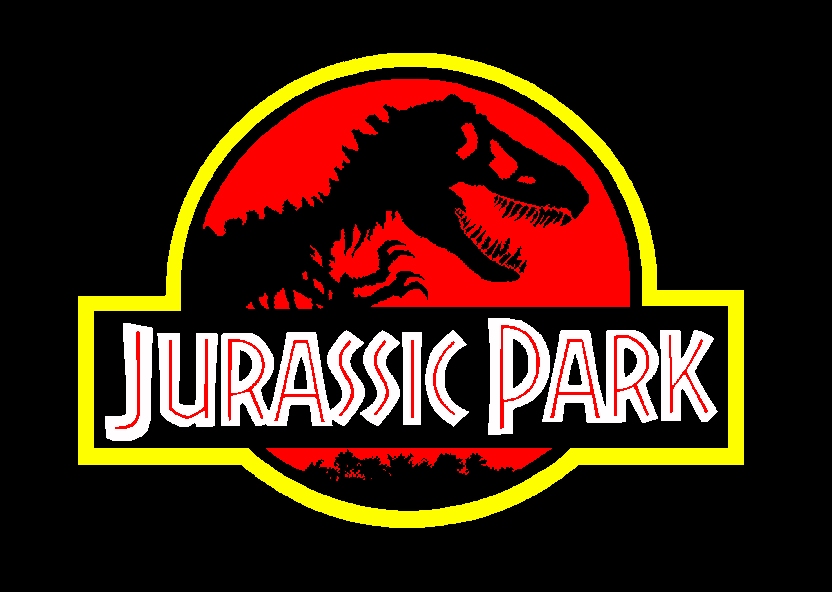
The culprit.
Yes, yes, you’ve heard it all before: those dinosaurs weren’t quite good enough to be true. Still, there’s no better topic than one you already know, especially if you want to be filled with a pleasingly smug sense of your own intellectual superiority. I heartily recommend it.
First up, we’ll tackle the biggest carnivore in the film: the ever-popular crowd pleaser Tyrannosaurus Rex.
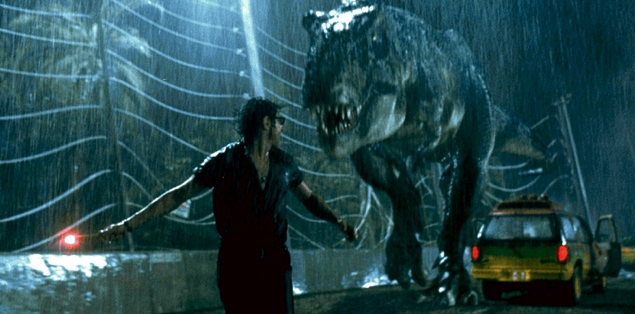
Mathematicians, although fun for a rex, are not nutritious.
The rex of Jurassic Park has a few issues, at least one of which is made to be a much bigger issue in the book than the film – that it cannot perceive moving objects very well, operating on a visual system similar to that of a frog.
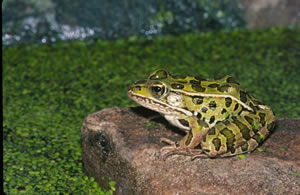
Not a Tyrannosaurus.
Unfortunately, reasons given for this unlikely biological similarity were somewhat flimsy, consisting as they did of “well, it sounds neat.” Michael Crichton himself altered the issue in his sequel, The Lost World, stating that it was total bull in-story through a combination of exposition and having a moron who believed it getting eaten by a pair of angry T. Rexes. It’s not really played up much in the movie, aside from the advice given by Grant while being stared at point-blank range by the rex, which has the side effect of making it sound even more bizarre (“Yeah, sure he can’t see us. He’s looking right at us!“)
Next up is something a bit more noticable: the rex’s run speed. In the movie, it manages to keep pace with a speeding jeep for a good distance. In the book and movie, it’s maintained that it can reach around or over forty miles per hour.
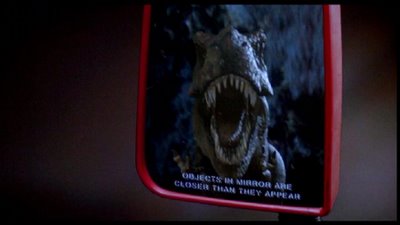
Sadly enough, this is not likely.
The problem with this is that it’s just simply not very likely that a Tyrannosaurus could work itself up to that speed at all, let alone keep going long enough to catch up to the car. Furthermore and somewhat more violently, if it fell over while going at that speed it would probably mash several very important bones into powder and suffer severe internal injuries. If a mouse falls over while running, it gets up. If a human falls over mid-jog, he can break a wrist or twist an ankle. If an elephant falls over while charging, it can seriously hurt itself. And if a t-rex fell over while moving at a full run, let alone at the speed shown in the movies…..ouch wouldn’t even begin to describe it. Part of the debate on Tyrannosaurus‘s dietary lifestyle (predator or scavenger) came into this at one point, stating that it wouldn’t have been able to move quickly enough to be an active predator. This debate is largely defunct now due to evidence of healing wounds from tyrannosaur teeth found in several skeletons of herbivorous dinosaurs from its time, along with an injection of common sense: almost no predator passes up a free meal, and almost no scavenging animal does not hunt and kill for food as well. Of course it ate dead stuff it found – what carnivore wouldn’t? And given the massive amount of muscles that would allow it to plow its mouth into something at a full, lumbering run, with every inch of its gargantuan bulk’s force and power packed into its jagged fangs that shredded apart helpless flesh and muscles and tore into the very bone itself – ahem. Anyways, yes, it definitely killed things.
Next up on our list is a somewhat lesser-known star, one overshadowed by the movie’s more-iconic beasties: the Dilophosaurus.
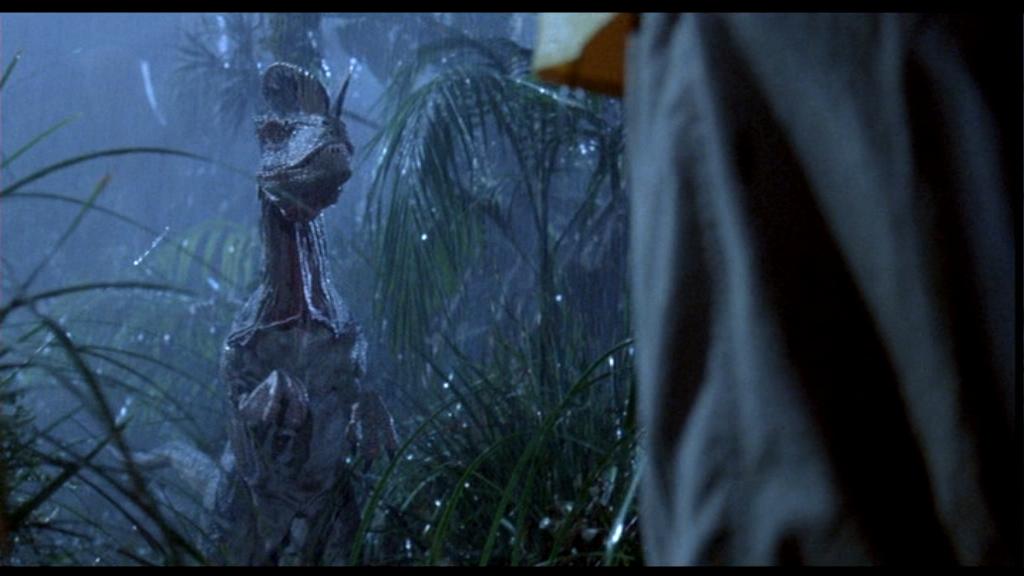
Was likely not this adorable in real life, even including the bit where it blinded a guy and ripped his guts out.
The Dilophosaurus of Jurassic Park suffered extensively from scaling difficulties; its size in the movie is solely as it is because otherwise it was felt that the watchers would confuse it with the Velociraptors. Reason being? The real Dilophosaurus was twenty feet long, which you can’t help but contrast to the four-foot-nothin’ friendly little guy cozying up to Nedry’s thighs in this shot. One of the largest changes in the movie, and one that actually wasn’t contained within the book. That said, it could be that the one Nedry ran into was a baby, albeit a highly independant and assertive one, who knew exactly what it wanted out of life (a mouthful of soft, doritos-fattened flesh) and how to get it (delicious PG-13 violence).
Also movie-only was the Dilophosaur‘s spectacular frill. All that can be said in defense of this one is that there’s absolutely no way to prove that it did or did not exist, which can also be said of many concepts of God.
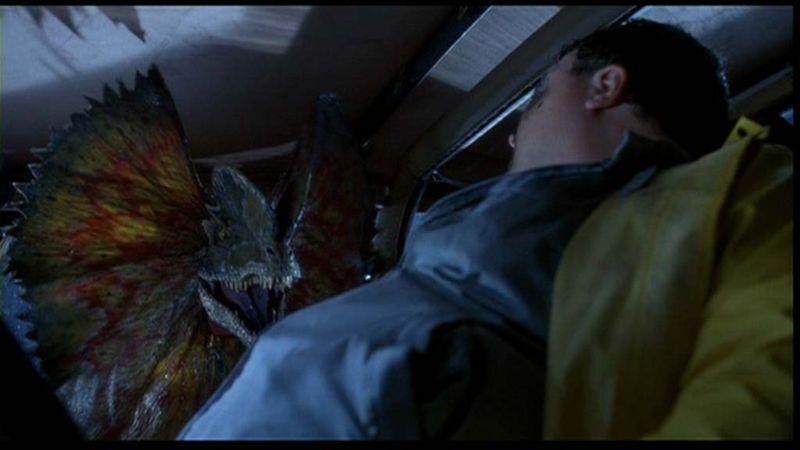
Probably not Yahweh, Allah, or any other comparative deity.
What was contained in the book, however, was the venom-spitting habits of the dinosaur, which, exactly like the frill, can neither be proven nor disproven, existing beyond the realm of science and within the hallowed halls of faith. At this point, Raptor Jesus should be mentioned, so I have. Now let no more be said of he who shall return in the velocirapture.
Speaking of such, the next dinosaur: Velociraptor.
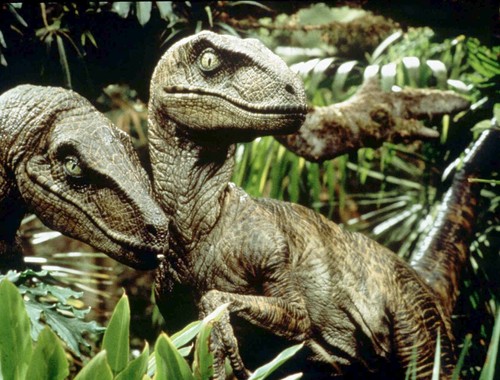
Don't be fooled. They're much less cuddly than they appear.
Velociraptor really had its name made with Jurassic Park – book and movie both. Unfortunately, their size and possible behaviour was based off of a completely different dinosaur – a close relative of theirs named Deinonychus that stood around five feet tall and eleven feet long. Velociraptor itself was a tragic 3-foot-tall, six-foot-long shrimp. Interestingly enough, a new member of the raptor family was discovered as Jurassic Park was filmed: Utahraptor. Standing 6 foot 6 inches tall and stretching 20 feet in length, it was far more like the Velociraptors of the movie than either of its cousins.
Additionally, like you hadn’t already guessed, real velociraptors probably weren’t able to beat cheetahs in footraces while outthinking chimpanzees, either. I’m not sure where you got this cynical.
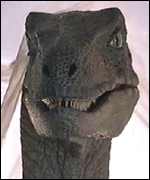
Not as smart as he thinks he is, the pictured dinosaur confessed recently to opening a door "totally by accident."
Despite all of this, Jurassic Park was one of the first movies to really make dinosaurs look real, and not just in the sense of using CG rather than iguanas with cardboard spikes attached to their backs. Their dinosaurs were ones you could see stomping through some ancient forest, alive and well. Not movie monsters, animals. Very big, very extraordinary animals, and for the most part the research done for both versions of the story was a hell of a lot more scientifically accurate than the norm, which is why we can pick at it like this. Naming scientific errors in some films just requires stating “the entire damned movie,” but Jurassic Park portrays things accurately enough that you can only find nuggets of inconsistency to bite and stab at.
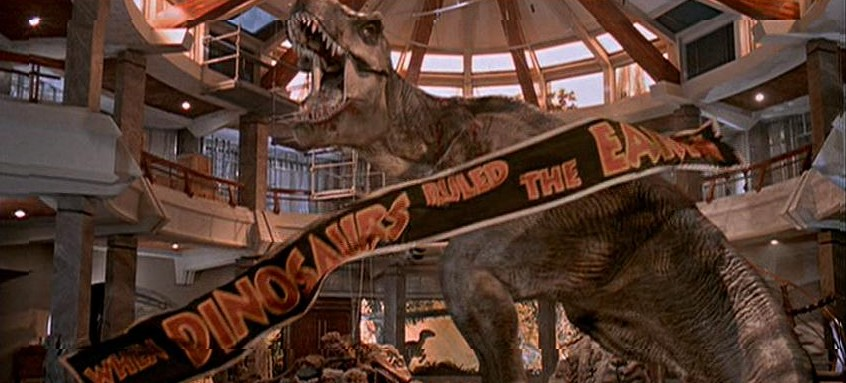
It was largely because of the film’s combination of visual splendour and “real-feel” creatures that the book/movie’s moral of “don’t screw around with bringing back long-extinct species” was loudly and easily overshadowed by the fact that they were obviously awesome. I don’t know about you, but I’d certainly trade say, several thousand dinosaur-related deaths per year for them to be back and able to cause those deaths in the first place. It’s not like we can’t spare the humans, and honestly, if there were no dinosaurs around, we’d just kill them ourselves anyways.
All original material copyright Jamie Proctor, 2009.
Picture Credits. All images are screenshots taken from Jurassic Park (1993, Universal Studios) unless noted otherwise. Those noted otherwise were located on Wikipedia.
Northern Leopard Frog: From government resource at http://www.umesc.usgs.gov/terrestrial/amphibians/mknutson_5003869_overview.html (public domain).